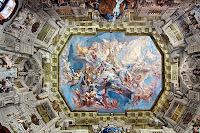The Belvedere palace is a baroque palace complex built by Prince Eugene of Savoy in the 3rd district of Vienna, south-east of the city centre. It houses the Osterreichische Galerie Belvedere museum. Prince Eugene bought a land in 1697 to create a large park.
 In 1714 work began to erect what is now called the Lower Belvedere, not as a palace but as a garden villa, with an orangerie, paintings gallery, and suitable living quarters. The architect was Johann Lukas von Hildebrandt, one of the most important architects of the Austrian Baroque, who produced in the complex of buildings his masterwork. He was assisted by the Venetian sculptor Giovanni Stanetti, who had been brought to Vienna by Prince Eugene. The Lower Belvedere was finished in 1716. The ceiling of its central Marmorsaal or Marble Hall, painted by Martino Altomonte, celebrates Prince Eugene as a new Apollo, leader of the Muses. The room also contains an Apotheosis of Prince Eugene sculpted by Balthasar Permoser.
In 1714 work began to erect what is now called the Lower Belvedere, not as a palace but as a garden villa, with an orangerie, paintings gallery, and suitable living quarters. The architect was Johann Lukas von Hildebrandt, one of the most important architects of the Austrian Baroque, who produced in the complex of buildings his masterwork. He was assisted by the Venetian sculptor Giovanni Stanetti, who had been brought to Vienna by Prince Eugene. The Lower Belvedere was finished in 1716. The ceiling of its central Marmorsaal or Marble Hall, painted by Martino Altomonte, celebrates Prince Eugene as a new Apollo, leader of the Muses. The room also contains an Apotheosis of Prince Eugene sculpted by Balthasar Permoser.On the west lies a State Bedroom suitable for levees, a room with delicate grottesche in the manner of Jean Berain, painted by Jonas Drentwett, the marble-gallery stucco-decorations and figures by Domenico Parodi. The inner marble-room with ceiling-paintings by Giacomo del Po from 1720. The Donnersaal has ceiling frescos by Altomonte and feigned architecture by Gaetano Fanti in 1716. To the east is a State Dining Room.
The garden had beautiful scenery, enclosed by clipped hedging, even as the Belvedere was building, in the formal French manner with graveled walks and jeux d'eau by Dominique Girard, who had trained in the gardens of Versailles as a pupil of Andre Le Notre. Its great water basin in the upper parterre and the stairs and cascades peopled by nymphs and goddesses that links upper and lower parterres survive, but the patterned bedding has long been grassed over; it is currently being restored.
In 1720-1723, the Upper Belvedere was built, originally intended simply to provide a suitable end to the main garden axis. The architect was again Johann Lukas von Hildebrandt. Once again there is a central Marmorsaal the site of the signing of the Austrian State Treaty, that formed modern Austria, May 15, 1955 but the Schloss was soon enlarged to provide the main summer residence of Prince Eugene. Its painted ceilings are by Carlo Innocenzo Carlone, with an altarpiece in the chapel by Francesco Solimena.

 The complex was sold in 1752 to Empress Maria Theresa of Austria by the prince's heiress. Maria Theresa first named the building Belvedere. Under the Habsburgs it was further extended. Since 1775, the Belvedere has housed the imperial picture gallery on behalf of Joseph II, and in 1806 the collection of Ambras Palace was moved to the Lower Belvedere as well. Both were transferred to the Museum of Art History or Kunsthistorisches Museum in 1890. The last to reside here was Archduke Franz Ferdinand.
The complex was sold in 1752 to Empress Maria Theresa of Austria by the prince's heiress. Maria Theresa first named the building Belvedere. Under the Habsburgs it was further extended. Since 1775, the Belvedere has housed the imperial picture gallery on behalf of Joseph II, and in 1806 the collection of Ambras Palace was moved to the Lower Belvedere as well. Both were transferred to the Museum of Art History or Kunsthistorisches Museum in 1890. The last to reside here was Archduke Franz Ferdinand.Since World War I, the Austrian Gallery museum resides in the Belvedere. The building suffered heavy damage during World War II. The Gold Cabinet burnt out and had to be reconstructed. The building is currently being given a facelift, with the beautiful restored garden already finished. The work is scheduled to be completed by 2008.
Post Title
→Belvedere Palace
Post URL
→http://guidice-galleries.blogspot.com/2010/01/belvedere-palace.html
Visit guidice galleries for Daily Updated Wedding Dresses Collection








